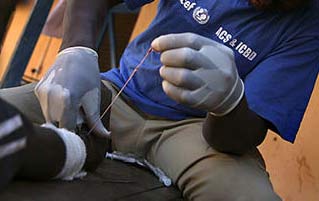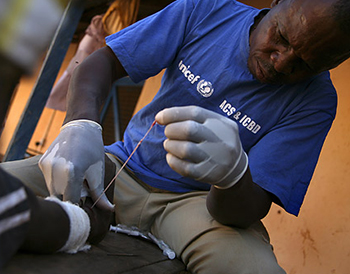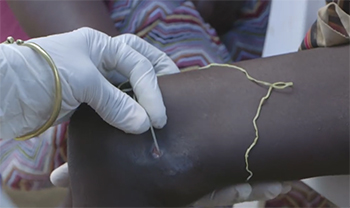Real Life Chestbursters: Battling The Dreaded Guinea Worm

The Guinea worm is a parasitic worm that bursts out of your body like the monster from Alien, only instead of living in space and feeding off John Hurt, it lives here on earth and feeds off you -- yes you, specifically. Uh ... supposing that you, specifically, are a very poor person in rural Africa. Here's one tied to a matchstick.

You're welcome!
Our source for today's article, Craig, was a volunteer field worker in Ethiopia in 2006. He helped with Guinea worm removals and told us all about it. Now we'll never feel clean again. On to the article!
Guinea Worm Doesn't Just Look Gross; It's Horrifically Painful
Other sick people don't spread the Guinea worm: it gets to you from the water. In its larval form, the worm lives inside microscopic pond life. It's currently "active" in four countries: Ethiopia, Chad, South Sudan, and Mali. Craig explained that once you drink them, "The eggs hatch, they grow and the worm comes out through your skin to lay more eggs."

"Y'know, I think life in South Sudan could stand to be a little harder." -- God, apparently
Having a Guinea worm erupt from your skin is like David Cronenberg directing your pimple:
"The first time I saw it in person, it was horrifying ... I was asked to bring gauze, and I saw him moaning in pain. He was shouting something with six inches of a worm coming out of his foot, and I asked what he was saying. My doctor's translator said, 'He says it's on fire.'"
That's a common description of the pain, too. And it lasts a lot longer than your average foot-fire. We're talking over a month, in some cases. The pain can make work and school impossible for weeks at a time.

Yeah, school kids. Because of course it's even more terrible than you initially thought.
"That first person was a farmer, and he had to stop working. Farming is really labor intensive out there, and every step he walked was like stepping on glass."
And not in a fun way, like that one Annie Lennox song; in a horrible and tragic way, like every other Annie Lennox song.
Of Course It Also Infects Your Genitals
Craig wanted to make damn sure we knew that, "It's ten times worse in person. Every time someone had it, I saw their face, the worm coming out, the blister, the discolored skin, their foot or leg swelling up. It was horrifying."

Thanks for clarifying, Craig, but we picked up on the "horrifying" part, already.
It should be noted that Craig didn't exactly volunteer to do this either. He went to Ethiopia on a church mission and found himself in one of the Guinea-wormiest parts of the country.
"After about a week, I started going out with the doctors that were with us. I didn't know any of the languages or know anything medical, so all I did was keep track of what was being used, how much was, and when it was busy, I assisted them as a sort of medical helper. Like, something I often did was hold open a book on Guinea worm eradication while one of the Ethiopians who helped us explained to the townspeople about prevention. I'm going to be honest and say it wasn't all that much, but the translator told me that having a white guy like me go with him made the presentation more believable. If that kind of thinking saved people from Guinea worm, then I was happy to play that role."

"That's a great visual aid, but it might look better next to a Caucasian."
During this time playing Credible-Looking Honky Number Three, Craig watched 11 Guinea worms escape from their fleshy prisons.
"Seven were in the foot, two were in the leg, one was somewhere (probably in the leg, but was too far away to see) and one was on the inside of the leg where the scrotum touches."
Yes, Guinea worms can infest your genitals. It turns out they're kind of all about infesting your genitals.

Not Safe For ... Just Not Safe. Unsafe. UNSAFE.
"It's the grossest thing I've ever seen. Even the doctors squirmed while doing it. If you have it, you can actually feel it coming out too. I never got used to it. You expect to see blood, but it doesn't come out. You expect to see a scab, but it never forms. It's this alive white string that comes out. It's so unnatural. Something alive digs its way out of you."
He then cleared his throat thoroughly, took a gentle sip of water, and never stopped screaming.
You Might Have It Right Now And Not Know For Months
Amidst the screams, Craig went on to elaborate about the pain. Because that helped:
"'Think of taking out a big splinter. Now imagine at least 30 of those big splinters being connected inside your skin and taking it out slowly. Now imagine it all being on fire.' You feel that. And if you pull too hard and the worm snaps, that part is stuck inside you even longer."

We've never needed a cut-away-from-the-horror kitten more than right now.
The pain doesn't start until the worm begins the chestburster phase of its lifecycle. In Guinea worm-affected regions of the world, this means every blister or sore might be a nightmare worm ready to tear its way into your life.
" were always bothered about blisters. You can usually tell if it's a Guinea worm blister apart from others, but some you can't, and they would get stressed out from not knowing. They would be in pain for a month, and no one wanted that. All I could do was tell them to visit the doctor. They'd listen too, because while they did use traditional medicine for some ailments, Guinea worm was not one of them. Through the years they probably tried every herb in the book, so having a doctor say if it is or isn't Guinea worm was a huge relief."

Nightmare fuel or ill-fitting sandal? Only time and screaming will tell.
After watching 11 of these hell-ribbons tear their way out of a human meat prison, Craig was worried that he might've swallowed one in an errant drop of water. But it can take as long as a year for the worm to go from 'larva' to 'leaving' in your body, so Craig stayed on edge for a long time, "For a year, it was in the back of my mind and I was looking for those blisters. I had stubbed my toes against a wall one day, and when I woke up in the morning the pain was there, and I temporarily forgot about the wall and my mind went to Guinea worm for a second. That one second of panic boosted my adrenaline before I realized, hey wait, you biffed your toes you idiot." Guinea worm is almost never fatal, but it sounds about as close to a haunting as nature gets.
Fighting The Disease Is Culturally Complicated
Over here in the privileged part of the world, where people mostly use the word 'parasite' to refer to elected officials, it's hard to talk about eradicating problems like this without sounding arrogant. Most people Craig spoke with felt that Westerners who provided aid treated them like they were just too dumb to avoid drinking worms. But the Ethiopians know they gamble on these monsters with every sip: it's just that they also know that not drinking water leads to death 100 percent of the time.

The fact that anyone was considering a sip of this water gives you an idea of how scarce the clean stuff can be.
"There's only so much water, and rather than die of dehydration, they'll drink water that has Guinea worm in it. People who have a worm coming out soak it to coax it out, and people drink in the same water because it's the only water that's close by. I was told they would drink water through their fingers or drip it down through cloth into a cup because they knew what caused it."
What the locals needed wasn't long-winded explanations of a worm they knew very well, but a shitload of donated nylon. Specifically, the nylon sheaths used to filter worm larvae out of the water. That's why the battle against Guinea worm has occasionally been referred to as "the nylon war."
"They knew the issue, but didn't have the means to fight it. That's all we really needed to give them."
The world's biggest advocate for Guinea worm genocide is actually Jimmy Carter, the Firefly of U.S. Presidents. His charity, The Carter Center, has been battling Guinea worm for decades and has been instrumental in fighting it.
"Everyone loves him because they're getting filters and getting rid of this. But they also see him as patronizing. They see him as the kind of person who says, 'Let ME show you how to drink water correctly.' Even the translator there felt this way. He told me 'Mr. Jimmy (Carter) has helped us so much, but we don't always like the WAY he does it.'"

Huh, that's a familiar sentiment.
There's No Cure, And The Side Effects Are A Nightmare
Once you have Guinea worm, there isn't much you can do. There's no cure. And most scientists agree that Cracked's suggested treatment of sending very tiny snakes in after the worm is "insane," "unworkable," and "would cause way more problems even if it was possible." So Craig explained the standard treatment in Ethiopia ...
"The way they would do it is take a plastic bin with water and put whatever infected area inside (you don't do it near a pond or other drinking water source because of egg spread). Once the worm comes out and spreads its eggs, they would wash and start twirling the worm around on a stick covered in gauze. To get it out quicker, it's the only way. You can't do it too fast though, because you can snap it. It takes a while to get out too because of how long they can get." (Guinea worms are the girth of a spaghetti noodle, but can grow to be over three feet long.)

Holy fuck; we cashed in our kitten image too early.
Slowly pulling out a Guinea worm with a stick has been the preferred method for basically ever. In fact, the design for the staff of Asclepius -- that snake wrapped about a pole symbol that medical professionals everywhere use -- was influenced by the pull out method for Guinea worm removal. But even once it's out, the infected person isn't in the clear. Common side effects, like lockjaw and joint infections, can lead to permanent disability. This weaponized spaghetti disease only affects the world's poorest 10 percent and, what with all the missed work and permanent injury, it doesn't exactly help that scenario.
Sepsis is a major post-surgery threat, because places with Guinea worm by definition lack clean water to clean stuff with. Craig said:
"I was on medical runs where I saw sepsis. Against the doctor's orders, people who had stitches or something else healed went back to work near animal and something got infected."

Which is sadly understandable when a doctor's orders contradict the ability to feed yourself.
General sepsis rates in Africa are impossible to figure out, mostly due to the fact that no African country releases info or studies about it -- but sepsis rates in Ethiopia for childbirth have been found to be high, with every birth having better than a 1 in 100 shot of causing sepsis. And what is Guinea worm removal, but a kind of birth? A kind of horrible, God-defying terror-birth?
We're Close To Wiping Guinea Worm Out, But There's A Catch ...
In 1989, there were almost a million cases of Guinea worm reported worldwide. By 2006, they had dropped down to 25,000 cases. In 2015, there were only 22. There were 25 cases reported in 2016, but the number of countries affected went down to three, which is one of the only good things we can say about that festering shitfire of a year. The successful fight against Guinea worm is one of those things that makes you proud to be human, in an era of orange racist presidents and five Transformer movies. In fact, Guinea worm disease is well on the track to be the third disease humanity has eradicated for good, after smallpox in 1980, and rinderpest in 2011.

Yup, just three. After the dodos and black rhinos, you'd think intentionally causing an extinction would be a cake walk.
"When I was in Ethiopia, every time I helped out with Guinea worm, they told me that in 10 years time we weren't going to see it anymore. Every doctor and translator I met said this. Once they told one of the women who had Guinea worm something like that, and she started smiling. The doctor who was treating her was doing something important and asked her to remain still, and the translator apologized and said 'Sorry, but she is so happy it's going to be gone forever. It's been around here for as long as anyone remembers.'"
Spearheading the charge is the Carter Center again, giving out aid and spreading health awareness. Jimmy "Guinea Worm's Most Wanted" Carter has even promised that Guinea worm will be eradicated before he dies.
"Carter and Bush aren't seen as particularly good presidents here, but in Africa -- they're heroes."

It does certainly put some of those opinion polls into perspective.
But there's a catch ... man's best friend might also be his worst enemy in this case. Even if you've never owned a dog, you know they stick their faces in absolutely everything, and cannot be trained to use nylon filters in the fetid ponds they drink from. Infected countries have seen a huge upswing in dog-infection cases -- with one dog alone having 62 worms come out of it. If you want to know what that looks like, just watch the kennel scene from The Thing like, eight times.
For years, we thought the Guinea worm could only survive in human beings. But over 600 dog cases alone were reported from Chad last year. Scientists have no idea how Guinea worm made the jump to our four-legged friends. But to have a good shot at 'cleansing' the dog population of worms, over 10,000 would have to be killed.
And that's the Guinea worm, for you: It screwed over people forever, and on its way out the door, it's gonna screw some pooches, too.
Think Nana and Pop-Pop's loving 60-year monogamous relationship is quaint and old-fashioned? First off, sorry for that disturbing image, but we've got some news for you: the monogamous sexual relationship is actually brand new relative to how long humans have been around. Secondly, it's about to get worse from here: monkey sex.
On this month's live podcast, Jack O'Brien and the Cracked staff welcome Dr. Christopher Ryan, podcaster and author of 'Sex at Dawn', onto the show for a lively Valentine's Day discussion about love, sex, why our genitals are where they are, and why we're more like chimps and bonobos than you think.
Get your tickets here:
For more insider perspectives, check out 5 Harsh Truths You Learn As A Doctor In The Third World and 4 Things I Learned Working With Deadly Diseases.
Subscribe to our YouTube channel, and check out The Horrifying Truth About Those People In TV Commercials, and other videos you won't see on the site!
Follow us on Facebook, and we'll follow you everywhere.
